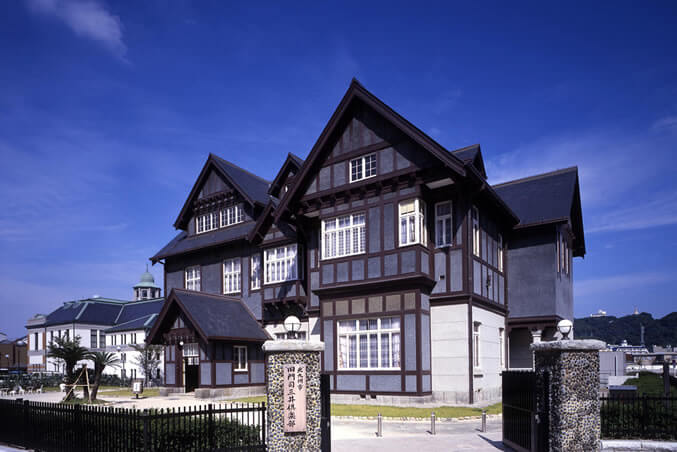
Course05Experiencing Japanese
Culture Course / 2 nights 3 days
First Day
-
- Start
- Kokura Station
-
About 30 mins
-
- 02
- Mojiko Retro
About 90 mins
-
- Goal
- Ajimu Green Tourism
Second Day
Third Day
First Day
-
01


- Kokura Caste, Shopping
- A symbol of the town, Kokura Castle is a famous castle which was built in 1602. Called “Karazukuri” at the time it was built, it was rare, the only castle like it in the whole country. What you see now is a reconstruction of the original and inside the castle there are zones where you can learn the history and culture of Kokura Castle, and the Observation Zone where you can see the streets of Kokura. It is also famous for the beauty of the 300 cherry trees in spring and the keyaki (Japanese elm) and ginkgo trees in the autumn. Additionally, in the vicinity of Kokura Station, large shopping malls and famous department stores are gathered so it is also a fun shopping area.
-
- Mojiko Retro
- In Mojiko harbor, which once prospered as an international trade port, Western-style buildings left from 100 years ago stand side. Symbolizing the retro district, Mojiko Station (under construction until 2018) and the Old Moji Mitsui Club, where Dr. Einstein is said to have stayed, are designated as important cultural properties of the country. Besides that, there is the former headquarters of the Kyushu Railroad Company which is now a railroad memorial museum, and the former municipal customs office, made of red brick, is preserved and open, so you can feel Japan's culture of the period.

02

-
Goal


- Ajimu Green Tourism
- How would you like to experience country living on a “farm stay” in Japan? Ajimumachi in Usa City is said to be where farm stays in various parts of Japan began. With the catch “a distant relative if you stay overnight, a true relative if you stay 10 times,” farmers will warmly welcome you. It is not only staying, but you can experience things like vegetable harvesting, making snacks, and more. It is a popular lodging experience and overall, 20% of those who try it are from other countries.
Second Day
-
01


- Usa
- Usa Jingu Shrine is known as the main shrine of all the 40,000 Hachiman Shrines nationwide and many people come to visit. Historically and culturally precious buildings are lined up, including the three main hall buildings, which are national treasures, the Kurehashi bridge on the western approach, and the treasure hall. The vast premises surrounded by old-growth forests from ancient times have a solemn atmosphere. Additionally, Usa City is said to be the birthplace of a karaage (fried chicken) specialty shop so there are many specialty shops. It is good with soy sauce and salt base, ginger and garlic, and you can enjoy the original flavor of each shop.
-
- Kunisaki
- Futagoji, on the mountainside of Mount Futago located in the center of the Kunisaki Peninsula, is a temple which was founded about 1300 years ago. The statue of Nio, which is settled in the mountain gate, is said to be the representative Nio of the Kanto peninsula from the beauty of its carvings. In the offering hall, there is Fudo Myouo, who protects against misfortune and ensures healthy childbirth, and enshrined in the inner temple is the Juichimen Kannon (eleven headed Kannon), who is beneficial for conception. Also, in the autumn on the grounds, there is a section of colored leaves spreading out and it is one of the most famous places to see the autumn color in the prefecture.

02

-
Goal


- Beppu
- Beppu Onsen shines as the nation's number one hot springs spot, with the most sources and quantity of water. Hot water and steam are frequently blown out of the "hell water spouts," and "Jigoku Meguri" (or hell tour), going to the eight natural thermal spring locations around Beppu, is a popular sightseeing course. Also, the noodle dish loved by locals "Beppu Reimen" is recommended. Usually it is noodles made of wheat or buckwheat in a soy sauce based cold soup with toppings like kimchee. There are two types of shops, shops that specialize in chewy thick noodles and grilled meat shops with thinner slurping noodles.
Third Day
-
01


- Hita
- In Mameda Machi, there are the remains of a prosperous Edo Period townscape. Once a neighborhood of merchant homes, Mameda Machi is called “Little Kyoto of Kyushu” and is full of emotion. The large scale river in Kyushu, the Chikugo River and Mikuma River flows to Hita, which has long been so blessed with water resources that it is called “Suikyo,“ which means a beautiful riverside location. Onsen hot springs inns are lined up along the river and in the summer you can eat ayu (fish) from the river. Hita's famous food is “Hita Yaki Soba,” and the special feature is the crisply noodles stir-fried on an iron pan. It's an excellent dish with vegetables, noodles, and sweet and spicy sauce.
-
- Dazaifu
- Dazaifu Tenman-gu Shrine, which worships the god of study, is visited by about 8,000,000 people every year and it is popular with tourists from abroad. On the grounds there are omikukuji (fortune slips) whose color changes with each season and a bronze bull statue which is said to make anyone who rubs his head smart, and it is also known as a place which boasts roughly 6,000 plum trees which bloom in February and March. The approach to the shrine is lined with shops selling "Umegae Mochi" (grilled mochi rice cakes filled with sweet red bean paste) and souvenirs. Red azuki bean paste wrapped in thin mochi, “Umegae Mochi” is eaten with one hand, so it is recommended for walking around.

02

